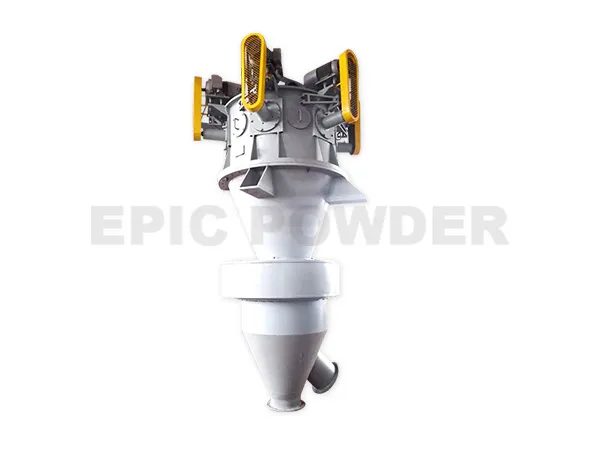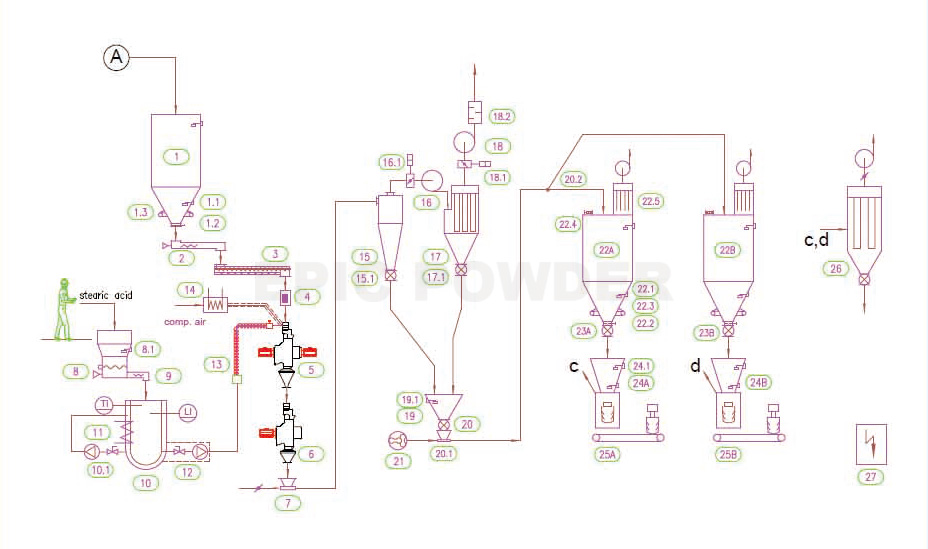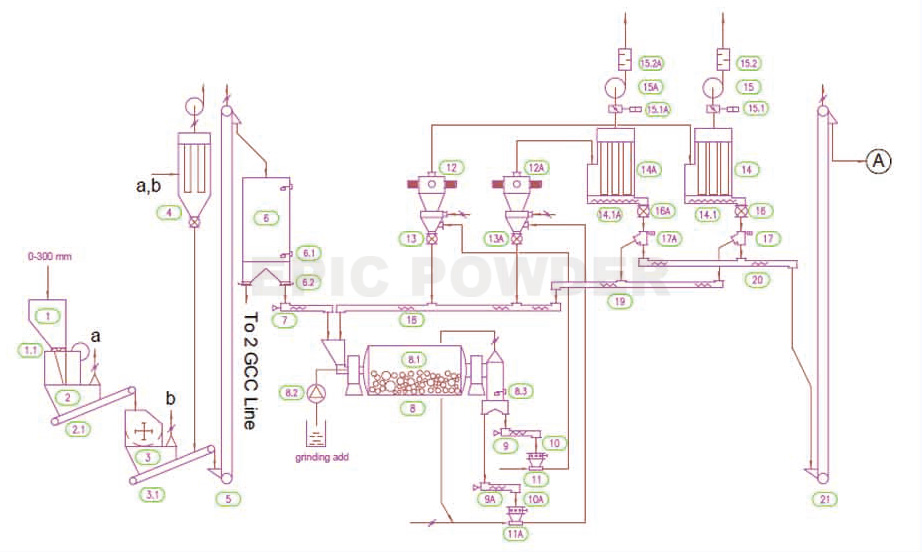
Horizontal Air Classifier
- Features:
High speed, accurate vertex cutting; clean production process; program control system, easy to adjust and operate. - Application:
Widely used in mineral industry (especially suitable for classification of non mineral products such as calcium carbonate, kaolin, quartz, talc, mica), metallurgy, abrasives, ceramics, refractory, medicine, pesticide, food, health care products, new materials, etc..
Horizontal Air Classifier working principle
HTS series airflow classifier is designed by our German classifier experts, specially used for efficient dry classification of d97 3 microns – d97 45 microns and other ultra-fine powders. Its most critical component is its internal grading rotor that can rotate at high speed, and the grading rotor is installed horizontally. The classifier, cyclone collector, dust collector and induced draft fan form a complete classification system. Under the gravitational force of the induced draft fan, the material quickly enters the classification cavity from the inlet of the classifier with the airflow of the fan; the classifying rotor rotating at high speed generates a strong centrifugal force to block the coarse particles, so that the coarse particles cannot pass through the gap between the blades of the classification wheel At the same time, the gravity of the fan partially overcomes the centrifugal force and sucks away the fine powder. The fine powder passes through the gap between the blades of the classifying wheel and enters the cyclone collector or directly enters the dust collector, thus achieving the purpose of separating coarse and fine materials. Coarse particles entrain some fine particles and lose speed after hitting the wall, and descend to the secondary tuyere along the cylinder wall. After the strong elutriation and dispersion of the secondary air, the coarse and fine particles are further separated, and the fine particles rise to the classification area for secondary classification. The particles descend to the discharge port for discharge, or are sent back to the crushing equipment for further crushing and grinding.
Features of Horizontal Air Classifier
Single Classifying Wheel Working Principle
- A horizontal mounted staged rotor, linear speed can reach 100m/s;
- The rotor speed can be adjusted by frequency conversion, and the force distribution can be adjusted flexibly;
- Suitable for precise classifying of dry micron material;
- Available D50:1.5-25μm.
Multiple Classifying Wheel Working Principle
- The rotor diameter is 315mm-630mm, and 2-6 rotors, which is used for ultra-fine powder classification;
- The classifying wheel increases the classifying space on the top of silo;
- Inverter control, adjustable speed;
- Higher output than single rotor.


Single Classifying Wheel Technical Parameters
| Parameter / Model | 70 | 100 | 140 | 200 | 260 | 315 | 400 | 500 | 630 | 750 | 1000 |
|---|---|---|---|---|---|---|---|---|---|---|---|
| Particle size(D97:μm) | 5-100 | 3-100 | 3-120 | 3-120 | 3-150 | 3-150 | 4-150 | 5-150 | 6-150 | 6-150 | 15-150 |
| Classification efficiency(η) | 60~80% | 60~80% | 60~80% | 60~80% | 60~80% | 60~80% | 60~80% | 60~80% | 60~80% | 60~80% | 60~80% |
| Classifier motor(kW) | 2.2 | 3 | 4 | 7.5 | 11 | 15/18.5 | 18.5/22 | 22/30 | 30/45 | 37/55 | 45/75 |
| Air volume(m³/h) | 150 | 300 | 600 | 1200 | 2000 | 3500 | 5600 | 8800 | 14000 | 20000 | 35000 |
Multiple Classifying Wheel Technical Parameters
| Parameter / Model | 200/4 | 315/3 | 315/4 | 315/6 | 400/6 | 500/3 | 500/4 | 500/6 | 630/6 |
|---|---|---|---|---|---|---|---|---|---|
| Particle size(D97:μm) | 5-100 | 3-100 | 3-120 | 3-120 | 4-150 | 5-150 | 6-150 | 6-150 | 6-150 |
| Classification efficiency(η) | 60~80% | 60~80% | 60~80% | 60~80% | 60~80% | 60~80% | 60~80% | 60~80% | 60~80% |
| Classifier motor(kW) | 2.2 | 3 | 4 | 7.5 | 11 | 18.5/22 | 22/30 | 30/45 | 37/55 |
| Air volume(m³/h) | 150 | 300 | 600 | 1200 | 2000 | 5600 | 8800 | 14000 | 20000 |
Projects
Projects in these field

What Precautions Should Be Paid Attention to during Grinding Process of Roller Mill?
Definition of roller mill Roller mill is an ultra-fine grinding

Application and Development of Calcium Carbonate in Coatings
Coatings can be seen everywhere in our lives, making our

Application and Grinding & Classifying Equipment of Mullite
Introduction of mullite Mullite is a high-temperature resistant mineral with
30M
RESPOND WITHIN 30 MINUTES
24H
PROVIDE TECHNICAL SOLUTIONS IN 24 HOURS
2H
REPLY TO CUSTOMER QUESTIONS IN 2 HOURS
72H
PROVIDE SOLUTIONS WITHIN 72 HOURS